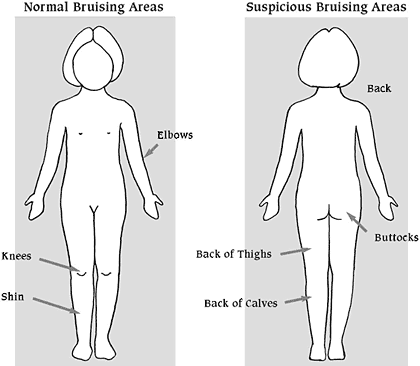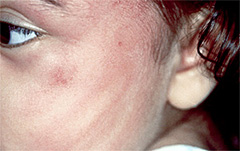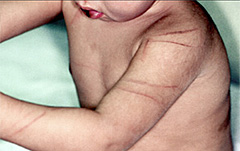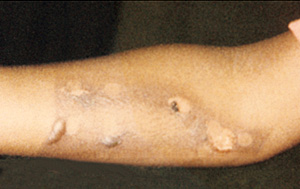INDICATORS OF CHILD MALTREATMENT AND ABUSE
There are many possible indicators of child maltreatment or abuse, and these indicators should be viewed together, not in isolation. Similarly, each indicator must be considered in relation to the child’s current age and circumstances and in the context of their physical condition or behavior.
Another important aspect to assessing for possible abuse is obtaining an explanation for the presenting concern and whether that explanation is consistent with the observed physical and behavioral indicators. Abuse or maltreatment should never be assumed.
The mandated reporter is encouraged to consider any prior experiences with the child and possible differences between past and present observations.
Any assessment must be objective and free from implicit or explicit bias.
Physical Indicators
Healthcare professionals must be alert for physical injuries that are unexplained or inconsistent with the parent or other caretaker’s explanation and/or the developmental state of the child. However, it is important to remember that indicators of maltreatment or abuse may not always be of a physical nature or visible to view.
BRUISING
Some bruises indicate likely child abuse. It is important to know both normal and suspicious bruising patterns when assessing children’s injuries. Normal bruising usually occurs in the front of the body over bony areas such as the forehead, knees, shins, and elbows.
The “TEN-4 rule” (see below) is a mnemonic aid to remember when bruising requires immediate evaluation. Children who are under 4 years should not have any bruises in these areas, and infants under 4 months should have no bruises anywhere. The size of the bruise is not as important as the location.
| T | Torso |
|---|---|
| E | Ears |
| N | Neck |
| 4 | Under 4 |
Suspicious bruises include the following:
- Bruises on babies who are not yet mobile (“cruising”)
- Bruises on the ears, neck, eyes, cheeks, buttocks, or torso (torso includes chest, back, abdomen, genitalia)
- Bruises that are clustered or patterned (e.g., handprints)
(Norton Children’s, 2020)

Normal and suspicious bruising areas. (Source: Research Foundation of SUNY, 2011.)

This pattern signals the blow of a hand to the face of a child. (Source: Research Foundation of SUNY, 2011.)

Regular patterns reveal that a looped cord was used to inflict injury on this child. (Source: Research Foundation of SUNY, 2011.)
LACERATIONS OR ABRASIONS
Typical indications of unexplained lacerations and abrasions that are suspicious include:
- On the face, lips, or mouth
- To external genitalia
BURNS
Unexplained burns include:
- Cigar or cigarette burns, especially on soles, palms, back, or buttocks
- Immersion burns by scalding water (sock-like, glove-like, doughnut-shaped on buttocks or genitalia; “dunking syndrome”)
- Patterned like an electric burner, iron, curling iron, or other household appliance
- Rope burns on arms, legs, neck, or torso

A steam iron was used to inflict injury on this child. (Source: Research Foundation of SUNY, 2011.)
FRACTURES
Unexplained fractures may include:
- Fractures to the skull, nose, or facial structure
- Multiple or spiral fractures
- Fractures in various stages of healing
(SD DSS, 2020)
HEAD INJURIES
Typical indications of unexplained head injuries include:
- Absence of hair and/or hemorrhaging beneath the scalp due to vigorous hair pulling
- Subdural hematoma (a hemorrhage beneath the outer covering of the brain, due to severe hitting or shaking)
- Retinal hemorrhage or detachment, due to shaking
- Whiplash or pediatric abusive head trauma
- Eye injury
- Jaw and nasal fractures
- Tooth or frenulum (of the tongue or lips) injury
PHYSICAL NEGLECT
Indicators of physical neglect include:
- Consistent hunger
- Poor hygiene (skin, teeth, ears, etc.)
- Inappropriate attire for the season
- Failure to thrive (physically or emotionally)
- Positive indication of toxic exposure, especially in newborns, such as drug withdrawal symptoms, tremors, etc.
- Delayed physical development
- Speech disorders
- Consistent lack of supervision, especially in dangerous activities or for long periods of time
- Unattended physical problems or medical or dental needs
- Chronic truancy
- Abandonment
Behavioral Indicators
Careful assessment of a child’s behavior may also indicate physical abuse, even in the absence of obvious physical injury. Behavioral indicators of physical abuse include the following:
- Withdrawal from friends or usual activities
- Changes in behavior (e.g., aggression, anger, hostility, or hyperactivity)
- Changes in school performance
- Depression, anxiety or unusual fears, or a sudden loss of self-confidence
- An apparent lack of supervision
- Frequent absences from school
- Reluctance to leave school activities, as if not wanting to go home
- Attempts at running away
- Rebellious or defiant behavior
- Self-harm or attempts at suicide
(Mayo Clinic, 2018)
A child may demonstrate behavioral indicators of neglect such as:
- Begging or stealing food
- Extended stays at school (early arrival or late departure)
- Constant fatigue, listlessness, or falling asleep in class
- Alcohol or other substance abuse
- Delinquency, such as shoplifting
- Reports there is no caretaker at home
- Runaway behavior
- Habit disorders (sucking, nail biting, rocking, etc.)
- Conduct disorders (antisocial or destructive behaviors)
- Neurotic traits (sleep disorders, inhibition of play)
- Psychoneurotic reactions (hysteria, obsessive-compulsive behaviors, phobias, hypochondria)
- Extreme behavior (compliant or passive, aggressive or demanding)
- Overly adaptive behavior (inappropriately adult, inappropriately infantile)
- Delays in mental and/or emotional development
- Suicide attempt
(Clermont County CPS, 2021)
ASSESSING FOR EDUCATIONAL NEGLECT
Poor school attendance, in and of itself, does not equate to a reasonable cause to suspect maltreatment, and a report of suspected educational neglect should be called in to the SCR only as a last resort. School personnel should first try working with the student, family, and community agencies to identify needs and resources available to meet those needs.
All of the following elements must be present to warrant a call to the SCR for educational neglect:
- Child must be of compulsory school age and currently living in NYS
- Child must be excessively absent without a valid reason or excuse
- The child’s education must be impaired due to the excessive absenteeism (or the child has an IEP and has missed necessary services due to excessive absenteeism)
- The parent or PLR has been made aware of the excessive absenteeism and impairment by means beyond simply sending a note home or leaving a voicemail message
- School officials have made efforts to engage the child and parent or PLR
- No parent or PLR has taken any action to rectify the situation
(NYS OCFS, 2022)
CAREGIVER RISK FACTORS
When health professionals observe indicators of possible abuse, they should consider whether the presence of risk factors in a caregiver may signal a need to examine the situation more carefully.
The National Child Abuse and Neglect Data System (NCANDS) cites the following caregiver risk factors:
- Alcohol abuse that is chronic
- Domestic violence in which the caregiver is the perpetrator or the victim
- Drug abuse that is chronic
- Financial problems that do not allow the family to meet basic needs
- Inadequate housing or homelessness
- Public assistance participation
- Any caregiver disability
(U.S. DHHS, 2021)
Indicators of Sexual Abuse
Child sexual abuse involves the coercion of a dependent, developmentally immature person to commit a sexual act with someone older. For example, an adult may sexually abuse a child or adolescent, or an older child or adolescent may abuse a younger child. A perpetrator does not have to be an adult in order to sexually abuse a child (RAINN, 2021).
The fact that sexual abuse may be carried out by a family member or friend further increases the child’s reluctance to disclose the abuse, as does shame and guilt plus the fear of not being believed. The child may fear being hurt or even killed for telling the truth and may keep the abuse secret rather than risk the consequences of disclosure. Very young children may not have sufficient language skills or vocabulary to describe what happened (Clermont County CPS, 2021; RAINN, 2021).
Child sexual abuse is found in every race, culture, and class throughout society. Girls are sexually abused more often than boys; however, this may be due to boys’—and later, men’s—tendency not to report their victimization.
Most perpetrators of child sexual abuse are people who are known to the victim. As many as 93% of children who are sexually abused under the age of 18 know the abuser. There is no particular profile of a child molester or of the typical victim. Even someone highly respected in the community—the parish priest, a teacher, or coach—may be guilty of child sexual abuse. Anyone, including parents, can be a perpetrator, and most are male.
Negative effects of sexual abuse vary from person to person and range from mild to severe in both the short and long term. Victims may exhibit anxiety, difficulty concentrating, and depression. They may develop eating disorders, self-injury behaviors, substance abuse, or suicide. The effects of childhood sexual abuse often persist into adulthood (Clermont County CPS, 2021; RAINN, 2021).
PHYSICAL INDICATORS OF SEXUAL ABUSE
Physical evidence of sexual abuse may not be present or may be overlooked. Victims of child sexual abuse are seldom injured due to the nature of the acts. Most perpetrators of child sexual abuse go to great lengths to “groom” the children by rewarding them with gifts and attention and try to avoid causing them pain in order to ensure that the relationship will continue.
If physical indicators occur, they may include:
- Symptoms of sexually transmitted diseases, including oral infections, especially in preteens
- Difficulty in walking or sitting
- Torn, stained, or bloody underwear
- Pain, itching, bruising, or bleeding in the genital or anal area
- Bruises to the hard or soft palate
- Pregnancy, especially in early adolescence
- Painful discharge of urine and/or repeated urinary infections
- Foreign bodies in the vagina or rectum
- Painful bowel movements
(Clermont County CPS, 2021; RAINN, 2021)
BEHAVIORAL INDICATORS OF SEXUAL ABUSE
Children’s behavioral indicators of child sexual abuse include:
- Unwillingness to change clothes for or participate in physical education activities
- Withdrawal, fantasy, or regressive behavior, such as returning to bedwetting or thumb-sucking
- Inappropriate, bizarre, suggestive, or promiscuous sexual behavior
- Inappropriate sexual knowledge for age
- Verbal disclosure of sexual assault
- Involvement in commercial sexual exploitation
- Forcing sexual acts on other children
- Extreme fear of closeness or physical examination
- Suicide attempts or other self-injurious behaviors
- Layered or inappropriate clothing
- Hiding clothing
- Lack of interest or involvement in activities
(Clermont County CPS, 2021; RAINN, 2021)
SEX TRAFFICKING / COMMERCIAL SEXUAL EXPLOITATION OF CHILDREN
The crime of sex trafficking of children is a type of child abuse increasingly encountered in the healthcare setting. It is defined in the Trafficking Victims Protection Act (18 USC §1591) as “to recruit, entice, harbor, transport, provide, obtain, or maintain by any means a person, or to benefit financially from such action, knowing or in reckless disregard that the person has not attained the age of 18 years and will be caused to engage in a commercial sex act.”
Victims of sex trafficking seldom self-disclose, and many will resist disclosure because they have been threatened or feel shame, guilt, or loyalty to the trafficker. Some youth do not self-identify as victims. It is important for healthcare providers to ask about exploitation because 88% of adolescent victims of trafficking reported an encounter with a healthcare provider during the time that they were being exploited.
Indicators in a Virtual Environment
Mandated reporters must be aware of indicators of abuse or maltreatment that can be assessed for in a virtual environment for such children who attend school remotely, visit doctors using telemedicine, or participate in therapy sessions on virtual platforms.
Recommendations for assessing for potential abuse or maltreatment when interacting in a virtual environment include:
- Use reliable technology with adequate lighting and sound.
- Confirm the child’s physical location in the event you need to contact emergency services.
- Provide clear channels to reach out, such as email, phone, chat, text, or online tools.
- Make sure the child is present for at least part of the virtual interaction.
- Be alert if a child turns off a webcam or is very hesitant to use one.
- Ask everyone to introduce themselves who is in the room with the child or who enters the room after the visit starts.
- Be alert for indications that a child is trying to communicate something without someone else in the room noticing.
- Pay attention to nonverbal cues (e.g., if a child’s demeanor or behavior is different when someone else enters the room).
- Listen for concerning statements a child makes, including to siblings or peers.
- Be alert for altercations between children or adults. (Even if altercations do not rise to a level of suspected abuse, they may create an opportunity for a conversation about safety or managing stress.)
- Observe the child’s body for possible physical indicators, even if only the face, neck, shoulders, or chest may be visible.
- Note behavior in the child that indicates depression or anxiety.
- Ask if there is enough privacy for the child and/or parent to discuss sensitive matters. This may mean asking nonparticipating household members to move to a different room.
- Assess the environment (e.g., Are there noticeable unsafe conditions? Is there appropriate supervision for the child? Are young children watching even younger siblings?)
- Watch carefully, verbalize one’s observations, and ask if the family agrees.
(NYS OCFS, 2022)